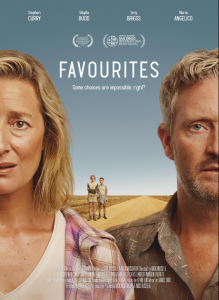As a new season truly gets underway, we are going to look at some shorts that played at the recently wrapped Tribeca Film Festival. In this first part of a two-part wrap-up of the New York City-based fest, we will be looking at three films that deal with youth in some form, and these films range greatly in tone. Could there be an upcoming awards contender in this trio?
 Clodagh
Clodagh
Every day, Mrs. Kelly prepares a Catholic priest’s home and robes as part of her daily routine as a housekeeper. She works in silence as she makes sure everything is in order and everything is cleaned properly and we immediately sense that she performs every duty in her life with respect and honesty.
Mrs. Kelly also teaches a traditional Irish step-dancing class, and she is approached in the parking lot by a father looking to place his daughter somewhere to ease his strife. He pleads with Mrs. Kelly to accept her so he can get a tiny bit of respite as a single father. When Mrs. Kelly accepts to let Clodagh sit in on the class, she doesn’t expect that this young lady will have the instincts and the unadulterated talent that blow her away. Clodagh is quiet and respectful, but her dancing is ferocious and passionate–it’s unlike anything that Mrs. Kelly has experienced in a long time–so she wants to ensure that this young woman has every chance that she was never afforded.
Portia A. Buckley’s film shows people who are shaken awake by something pure even if a particular circumstance stands in Mrs. Kelly, and ultimately, Clodagh’s way. We begin to wonder how much Mrs. Kelly has had to sacrifice in order to keep the peace and not cause a fuss. The central performance, from Bríd Ní Neachtain, is nothing short of extraordinary. Her eyes paint the portrait of a woman who didn’t know she was capable of such strength, and she holds the pen to write Clodagh a better future. Clodagh is mighty and strong but retains the delicacy of the human spirit.
 Favourites
Favourites
Oh, how delightfully dark Nick Russell’s directorial debut is. It’s equal parts Sophie’s Choice and Force Majeure.
A family on vacation bursts into a clinic after their two young teenagers are bitten by a snake. The scene is frantic, and both of the youngsters lay unconscious on the floor. Their parents, played by Stephen Curry and Sibylla Budd, tell the doctor and nurses that they raced here, and the doctor reassures them that they got to the clinic just in time. When the nurse comes back with the proper antidote, she brings the worst news with her: there is only one dose left. The music swells, the emotions stir, and Curry’s character does not hesitate in which child he wants to save.
There are times when things fly out of your mouth, and you realize that there is no going back. Russell’s film will leave you howling with laughter for how treacherously honest it is. This is humor filled to the brim with the most unwanted honesty imaginable. What Russell does with a little over five minutes is remarkable.
Kum-Kum
The sounds of waves crashing fills our ears as we begin Dur Jamjoom’s Kum-Kum, a coming-of-age short with tragic undertones. We should associate that sound with peace and relaxation, but, for one young girl, is will be associated with pain and grief.
Seventeen-year-old Duna has invited her friends over to hang out at the beach. Their mother brings them snacks as they play Kum-Kum, a game that they all played as kids, but Salwa needs to be taught how to play. After a few rounds, they girls decided to head to the water. Salwa takes her time to pray and then meets the girls, even though she isn’t the best swimmer. Duna is woken up on her kayak by the sounds of screams and cries for help, and we soon discover that Salwa has drowned.
How does one parse through the responsibility after such a thing transpires? No one is blaming any of the young women who were there, but perhaps they should’ve taken more consideration knowing that Salwa wasn’t as comfortable on the water. Jamjoom’s focus feels like it’s about moving forward. Duna sits at the wake and considers what she could’ve done–a natural, nagging feeling. It’s something that comes naturally to grieving, but to have to consider this at such an important age is heartbreaking.
I love how Jamhjoom uses sound and cinematography to ground us. We can feel the cold sand as we listen to the waves lapping in the distance. Jamjoom closes her film with a simple image: one woman teaching a child something seemingly simple. We cannot help but stare at how the sun meets the edge of the water, and we know in that moment that healing can be lonely and singular but it is also essential.





![2025 Oscars: Can a Late-Breaker Still Win Best Picture? [POLL]](https://www.awardsdaily.com/wp-content/uploads/2024/10/gladiator-350x250.jpg)
